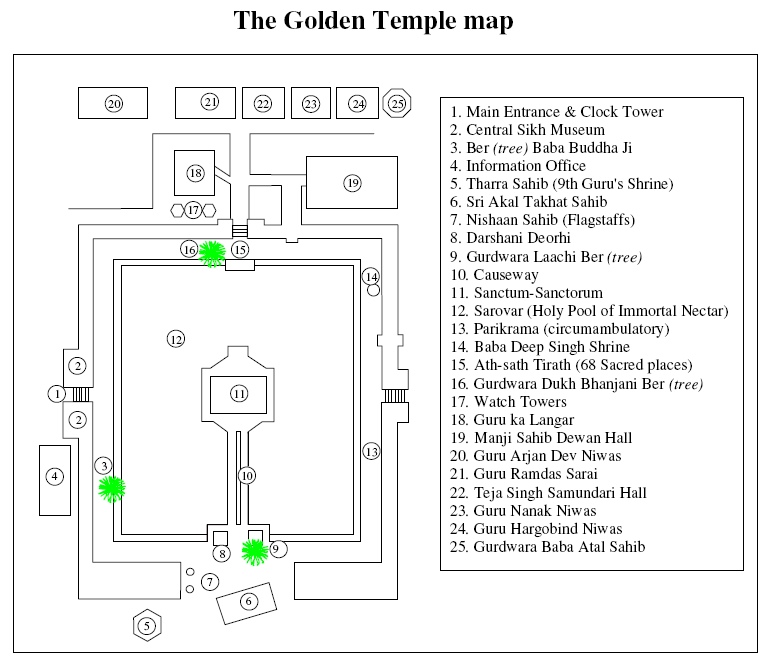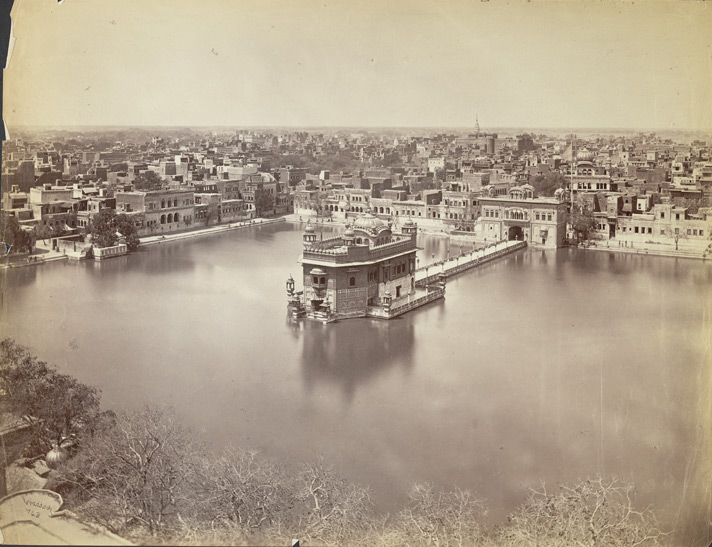
According to the Sikh historical records, the land that became Amritsar and houses the Harimandar Sahib was chosen by Guru Amar Das – the third Guru of the Sikh tradition. It was then called Guru Da Chakk, he then asked his disciple Ram Das to find land to start a new town with a man made pool as its central point. Ram Das succeeded Guru Amar Das in 1574, and given the hostile opposition he faced from the sons of Guru Amar Das, Guru Ram Das founded the town that came to be known as "Ramdaspur".

Guru Ram Das started by completing the pool with the help of Baba Buddha. Guru then built his new official centre and home next to it. He invited merchants and artisans from other parts of India to settle into the new town with him.
Ramdaspur town expanded during the time of Guru Arjan Dev financed by donations and constructed by voluntary work. The town grew to become the city of Amritsar, and the pool area grew into the Golden Temple complex. The construction activity between 1574 and 1604 is described in Mahima Prakash Vartak, a semi-historical Sikh hagiography text likely composed in 1741, and the earliest known document dealing with the lives of all the ten Gurus.
Guru Arjan installed the scripture of Sikhism inside the new temple in 1604. Continuing the efforts of Guru Ram Das, Guru Arjan established Amritsar as a primary Sikh pilgrimage destination. He wrote a voluminous amount of Sikh scripture including the popular Sukhmani Sahib.
Guru Ram Das acquired the land for the site. Two versions of stories exist on how he acquired this land. In one based on a Gazetteer record, the land was purchased with Sikh donations of 700 rupees from the owners of the village of Tung. In another version, Emperor Akbar is stated to have donated the land to the wife of Guru Ram Das.

Darbar Sahib with Clock Tower under construction
ca. 1860's, albumen print, SSB Collection
With the demolition of the lost palace in 1862, this photograph shows the construction work on the new gothic clock tower that replaced it underway. Wooden scaffolding can be seen supporting the new tower during its construction. This project would continue for a decade before the gothic clock tower was finally completed.

From the Temple gardens over the sacred Tank and Temple to the Clock Tower and City, Amritsar
Realistic Travels, ca. 1890s, stereoview, SSB Collection

The Golden Temple, sacred lake and clock tower, Amritsar IndH.C. White Co., ca. 1907, stereoview, SSB Collection. A turn of the century photograph highlighting the gothic towers odd appearance in relationship to Darbar Sahib.
This clock tower was demolished later. Looking completely out of place at Darbar Sahib the clock tower was an eye sore and much hated by the Sikhs yet it would endure for over 70 years.
In 1581, Guru Arjan initiated the construction of the Gurdwara. During the construction the pool was kept empty and dry. It took 8 years to complete the first version of the Harmandir Sahib. Guru Arjan planned a temple at a level lower than the city to emphasize humility and the need to efface one's ego before entering the premises to meet the Guru.He also demanded that the temple compound be open on all sides to emphasize that it was open to all. The sanctum inside the pool where his Guru seat was had only one bridge to emphasize that the end goal was one.
1589, the temple made with bricks was complete. Guru Arjan is believed by some later sources to have invited Sufi saint Mian Mir of Lahore to lay its foundation stone, signaling pluralism and that the Sikh tradition welcomed all. After the inauguration, the pool was filled with water. On August 16, 1604, Guru Arjan completed expanding and compiling the first version of the Sikh scripture and placed a copy of the Adi Granth in the temple. He appointed Baba Buddha as the first Granthi.
A 1880 photograph of the Golden Temple, sacred pool and the nearby buildings. The walled courtyard and entrances were added later.
The temple was repeatedly rebuilt by the Sikhs after it became a target of persecution and was destroyed several times by the Muslim armies from Afghanistan and the Mughal Empire. The army led by Ahmad Shah Abdali, for example, demolished it in 1757 and again in 1762, then filled the pool with garbage. Maharaja Ranjit Singh after founding the Sikh Empire, rebuilt it in marble and copper in 1809, overlaid the sanctum with gold foil in 1830. This has led to the name the Golden Temple.
The temple was repeatedly rebuilt by the Sikhs after it became a target of persecution and was destroyed several times by the Muslim armies from Afghanistan and the Mughal Empire. The army led by Ahmad Shah Abdali, for example, demolished it in 1757 and again in 1762, then filled the pool with garbage. Maharaja Ranjit Singh after founding the Sikh Empire, rebuilt it in marble and copper in 1809, overlaid the sanctum with gold foil in 1830. This has led to the name the Golden Temple.
Enjoy the Heritage street:
https://youtu.be/Brtdclnet4w
No comments:
Post a Comment